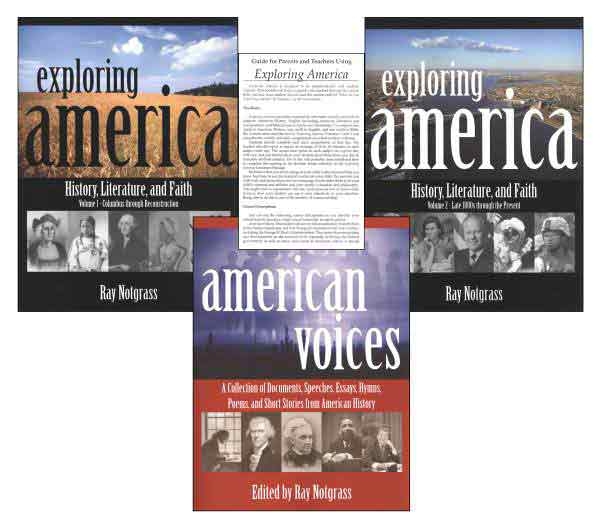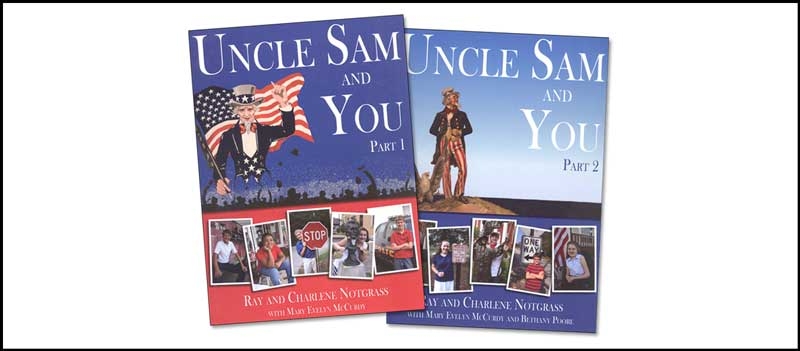 History is only the beginning of what this well-planned and user-friendly curriculum from the Notgrass family has to offer. The history is there, of course, in two large (about 500 pgs each, pb) Texts. Part 1 takes the reader from the Native American nations (excellent coverage, by the way) through Reconstruction; Part 2 covers from the late 1800s to the present. The same comfortable readability we’ve seen in other Notgrass courses is divided into daily lessons (150) and grouped into weekly units (30). If you’re emphasizing America’s beauty, it helps to have full-color pictures among the carefully selected artwork, and they do! Each unit is introduced by a short overview and a list of the lessons and books needed. Accompanying activities for each lesson might include “thinking biblically” (scripture copywork or Bible study), vocabulary, map study (weekly), literature (readings from We the People along with other suggested readings), creative writing, timeline work, and a family activity (more about these later). Each lesson also includes optional assignments for the Student Workbook or the Lesson Review book. If this sounds like a lot, keep in mind that this course only really needs a little additional grammar study to be social studies, Bible, and language arts – all in one.
History is only the beginning of what this well-planned and user-friendly curriculum from the Notgrass family has to offer. The history is there, of course, in two large (about 500 pgs each, pb) Texts. Part 1 takes the reader from the Native American nations (excellent coverage, by the way) through Reconstruction; Part 2 covers from the late 1800s to the present. The same comfortable readability we’ve seen in other Notgrass courses is divided into daily lessons (150) and grouped into weekly units (30). If you’re emphasizing America’s beauty, it helps to have full-color pictures among the carefully selected artwork, and they do! Each unit is introduced by a short overview and a list of the lessons and books needed. Accompanying activities for each lesson might include “thinking biblically” (scripture copywork or Bible study), vocabulary, map study (weekly), literature (readings from We the People along with other suggested readings), creative writing, timeline work, and a family activity (more about these later). Each lesson also includes optional assignments for the Student Workbook or the Lesson Review book. If this sounds like a lot, keep in mind that this course only really needs a little additional grammar study to be social studies, Bible, and language arts – all in one.
The Curriculum Set includes the two texts mentioned above as well as We the People and a comprehensive answer key along with both the Maps and the Timeline books (six books total). The original source reader that accompanies each Notgrass course is one of my favorite parts. We the People provides the same variety – books and stories, newspaper articles, documents, poems, journals, memoirs and biographies, speeches, letters, and songs – as their other courses, and skimming through it took me for a trip down memory lane and long ago classroom recitations. It’s obvious that creative planning went into the family activities provided for each unit and found in the back of each text. Family Commemorative Coins, a Cupcake Factory, an Erie Canal diorama, and a Liberty Bell mosaic give an idea of the breadth of ideas.
It’s hard to imagine a thorough study of American history without good map and timeline work. There are no worries here! Maps of America the Beautiful provides both a high quality map and accompanying assignments for each weekly unit. Corresponding to the chronological development of our country, you’ll find the expected maps (colonies, westward expansion, battles, etc.) but also some more unusual sets – America’s Islands, for example. You’ll want a quality set of colored pencils (the authors recommend Prismacolor pencils and I second this) – red, orange, yellow, green, blue, purple, pink, black, gray, and brown – to complete the map assignments. Timeline of America the Beautiful provides an enjoyable timeline-creating experience. Arranged vertically (what a great idea!) on the page, each page depicts a ten-year slice of American life. Some events are noted already, but others are to be carefully written by the student as part of daily and weekly assignments (lines are provided). As space permits, high-quality line-art pictures are provided which can be colored (another use for those Prismacolors).
Two optional supplements coordinate with the course. The Student Workbook provides an activity page for each lesson. Offering plenty of variety, activities include crosswords, word searches, matching, rebus stories, fill-in-the-blanks, illustrations, multiple-choice and more. The Lesson Review book provides five questions for daily review and for literature selections as well as unit quizzes. Answers to both of these books are found in the Answer Key.
— Janice





